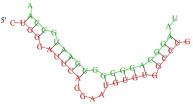当前位置:
X-MOL 学术
›
J. Diabetes its Complicat.
›
论文详情
Our official English website, www.x-mol.net, welcomes your feedback! (Note: you will need to create a separate account there.)
Analysis of the therapeutic potential of miR-124 and miR-16 in non-alcoholic fatty liver disease
Journal of Diabetes and its Complications ( IF 3 ) Pub Date : 2024-03-12 , DOI: 10.1016/j.jdiacomp.2024.108722 Ali Mahmoudi , Amin Jalili , Seyed Hamid Aghaee-Bakhtiari , Reza Kazemi Oskuee , Alexandra E. Butler , Manfredi Rizzo , Amirhossein Sahebkar
Journal of Diabetes and its Complications ( IF 3 ) Pub Date : 2024-03-12 , DOI: 10.1016/j.jdiacomp.2024.108722 Ali Mahmoudi , Amin Jalili , Seyed Hamid Aghaee-Bakhtiari , Reza Kazemi Oskuee , Alexandra E. Butler , Manfredi Rizzo , Amirhossein Sahebkar

|
Non-alcoholic fatty liver disease (NAFLD) is a common condition affecting >25 % of the population worldwide. This disorder ranges in severity from simple steatosis (fat accumulation) to severe steatohepatitis (inflammation), fibrosis and, at its end-stage, liver cancer. A number of studies have identified overexpression of several key genes that are critical in the initiation and progression of NAFLD. MiRNAs are potential therapeutic agents that can regulate several genes simultaneously. Therefore, we transfected cell lines with two key miRNAs involved in targeting NAFLD-related genes. The suppression effects of the investigated miRNAs (miR-124 and miR-16) and genes (TNF, TLR4, SCD, FASN, SREBF2, and TGFβ-1) from our previous study were investigated by real-time PCR in Huh7 and HepG2 cells treated with oleic acid. Oil red O staining and the 3-(4,5-dimethylthiazol-2-yl)-2,5-diphenyl-2H-tetrazolium bromide (MTT) assay were utilized to assess cell lipid accumulation and cytotoxic effects of the miRNAs, respectively. The pro-oxidant-antioxidant balance (PAB) assay was undertaken for miR-16 and miR-124 after cell transfection. Following transfection of miRNAs into HepG2, oil red O staining showed miR-124 and miR-16 reduced oleic acid-induced lipid accumulation by 35.2 % and 28.6 % respectively ( < 0.05). In Huh7, miR-124 and miR-16 reduced accumulation by 23.5 % and 31.3 % respectively ( < 0.05) but without impacting anti-oxidant activity. Real-time PCR in HepG2 revealed miR-124 decreased expression of TNF by 0.13-fold, TLR4 by 0.12-fold and SREBF2 by 0.127-fold ( < 0.05). miR-16 decreased TLR4 by 0.66-fold and FASN by 0.3-fold (p < 0.05). In Huh7, miR-124 decreased TNF by 0.12-fold and FASN by 0.09-fold ( < 0.05). miR-16 decreased SCD by 0.28-fold and FASN by 0.64-fold ( < 0.05). MTT assays showed, in HepG2, viability was decreased 24.7 % by miR-124 and decreased 33 % by miR-16 at 72 h ( < 0.05). In Huh7, miR-124 decreased viability 42 % at 48 h and 29.33 % at 72 h (p < 0.05), while miR-16 decreased viability by 32.3 % (p < 0.05). These results demonstrate the ability of miR-124 and miR-16 to significantly reduce lipid accumulation and expression of key pathogenic genes associated with NAFLD through direct targeting. Though this requires further investigation.
中文翻译:

miR-124和miR-16对非酒精性脂肪肝的治疗潜力分析
非酒精性脂肪肝 (NAFLD) 是一种常见疾病,影响全球 25% 以上的人口。这种疾病的严重程度从简单的脂肪变性(脂肪堆积)到严重的脂肪性肝炎(炎症)、纤维化,以及终末期的肝癌。许多研究已经确定了几个关键基因的过度表达,这些基因对于 NAFLD 的发生和进展至关重要。 miRNA 是可以同时调节多个基因的潜在治疗剂。因此,我们用两个参与靶向 NAFLD 相关基因的关键 miRNA 转染细胞系。通过实时 PCR 在 Huh7 和 HepG2 细胞中研究了我们之前研究中所研究的 miRNA(miR-124 和 miR-16)和基因(TNF、TLR4、SCD、FASN、SREBF2 和 TGFβ-1)的抑制效果用油酸处理。油红O染色和3-(4,5-二甲基噻唑-2-基)-2,5-二苯基-2H-四唑溴化物(MTT)测定分别用于评估细胞脂质积累和miRNA的细胞毒性作用。细胞转染后对 miR-16 和 miR-124 进行促氧化剂-抗氧化剂平衡 (PAB) 测定。将 miRNA 转染到 HepG2 后,油红 O 染色显示 miR-124 和 miR-16 分别减少油酸诱导的脂质积累 35.2 % 和 28.6 % ( < 0.05)。在 Huh7 中,miR-124 和 miR-16 的积累分别减少了 23.5% 和 31.3% (<0.05),但不影响抗氧化活性。 HepG2 中的实时 PCR 显示 miR-124 使 TNF 的表达降低 0.13 倍,使 TLR4 的表达降低 0.12 倍,使 SREBF2 的表达降低 0.127 倍(< 0.05)。 miR-16 使 TLR4 降低 0.66 倍,使 FASN 降低 0.3 倍 (p < 0.05)。在 Huh7 中,miR-124 使 TNF 降低 0.12 倍,使 FASN 降低 0.09 倍 (< 0.05)。 miR-16 使 SCD 降低 0.28 倍,使 FASN 降低 0.64 倍 (< 0.05)。 MTT 测定显示,在 HepG2 中,72 小时时,miR-124 使存活率降低 24.7%,miR-16 使存活率降低 33% (<0.05)。在 Huh7 中,miR-124 在 48 小时时活力降低 42%,在 72 小时时活力降低 29.33% (p < 0.05),而 miR-16 使活力降低 32.3% (p < 0.05)。这些结果证明 miR-124 和 miR-16 能够通过直接靶向显着降低脂质积累和与 NAFLD 相关的关键致病基因的表达。尽管这需要进一步调查。
更新日期:2024-03-12
中文翻译:

miR-124和miR-16对非酒精性脂肪肝的治疗潜力分析
非酒精性脂肪肝 (NAFLD) 是一种常见疾病,影响全球 25% 以上的人口。这种疾病的严重程度从简单的脂肪变性(脂肪堆积)到严重的脂肪性肝炎(炎症)、纤维化,以及终末期的肝癌。许多研究已经确定了几个关键基因的过度表达,这些基因对于 NAFLD 的发生和进展至关重要。 miRNA 是可以同时调节多个基因的潜在治疗剂。因此,我们用两个参与靶向 NAFLD 相关基因的关键 miRNA 转染细胞系。通过实时 PCR 在 Huh7 和 HepG2 细胞中研究了我们之前研究中所研究的 miRNA(miR-124 和 miR-16)和基因(TNF、TLR4、SCD、FASN、SREBF2 和 TGFβ-1)的抑制效果用油酸处理。油红O染色和3-(4,5-二甲基噻唑-2-基)-2,5-二苯基-2H-四唑溴化物(MTT)测定分别用于评估细胞脂质积累和miRNA的细胞毒性作用。细胞转染后对 miR-16 和 miR-124 进行促氧化剂-抗氧化剂平衡 (PAB) 测定。将 miRNA 转染到 HepG2 后,油红 O 染色显示 miR-124 和 miR-16 分别减少油酸诱导的脂质积累 35.2 % 和 28.6 % ( < 0.05)。在 Huh7 中,miR-124 和 miR-16 的积累分别减少了 23.5% 和 31.3% (<0.05),但不影响抗氧化活性。 HepG2 中的实时 PCR 显示 miR-124 使 TNF 的表达降低 0.13 倍,使 TLR4 的表达降低 0.12 倍,使 SREBF2 的表达降低 0.127 倍(< 0.05)。 miR-16 使 TLR4 降低 0.66 倍,使 FASN 降低 0.3 倍 (p < 0.05)。在 Huh7 中,miR-124 使 TNF 降低 0.12 倍,使 FASN 降低 0.09 倍 (< 0.05)。 miR-16 使 SCD 降低 0.28 倍,使 FASN 降低 0.64 倍 (< 0.05)。 MTT 测定显示,在 HepG2 中,72 小时时,miR-124 使存活率降低 24.7%,miR-16 使存活率降低 33% (<0.05)。在 Huh7 中,miR-124 在 48 小时时活力降低 42%,在 72 小时时活力降低 29.33% (p < 0.05),而 miR-16 使活力降低 32.3% (p < 0.05)。这些结果证明 miR-124 和 miR-16 能够通过直接靶向显着降低脂质积累和与 NAFLD 相关的关键致病基因的表达。尽管这需要进一步调查。



























 京公网安备 11010802027423号
京公网安备 11010802027423号